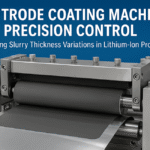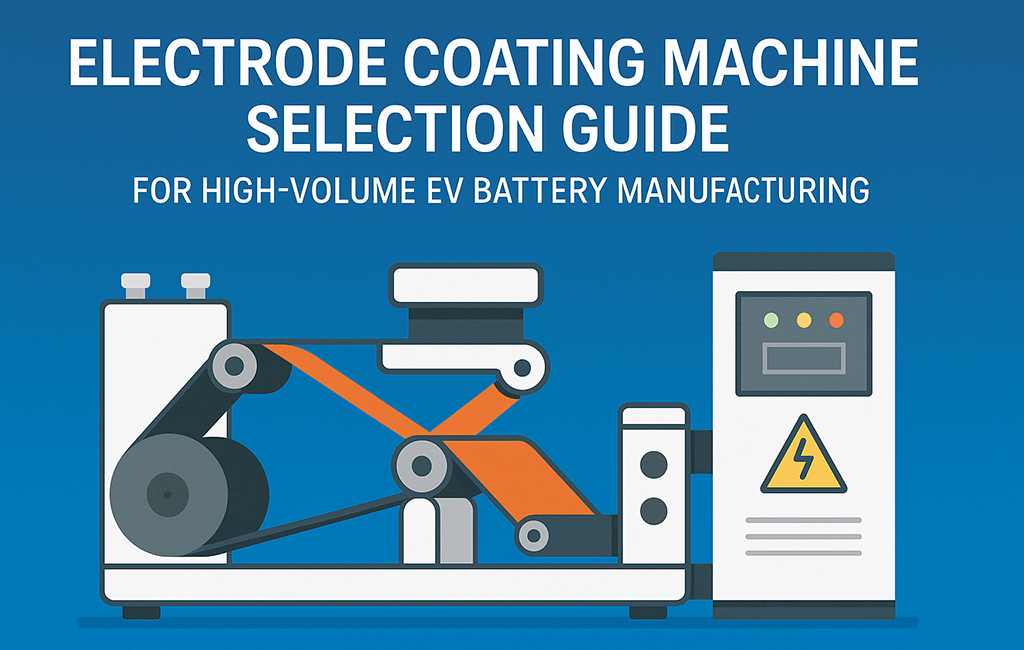Selecting the right electrode coating machine for gigafactory-scale production determines your success in meeting cost-per-kWh targets. Coating processes account for up to 25% of total battery cell manufacturing costs. They also directly impact 40% of final cell performance metrics.
This guide provides battery manufacturing engineers and procurement teams with actionable frameworks. You’ll learn how to evaluate coating equipment capable of producing 10-50 GWh annually. We examine real-world performance data, compare coating technologies, and provide ROI calculations specific to high-volume EV battery production.
What Coating Specifications Are Critical for EV Battery Production at Scale?
High-volume EV battery manufacturing demands coating equipment that maintains automotive-grade quality at speeds exceeding 80 m/min. The following specifications represent minimum requirements for gigafactory-scale production.
Coating Width and Speed Requirements
Production parameters vary by cell format and chemistry. Each specification directly impacts your facility’s output capacity and product quality.
- Production Width: 600-1,400mm for prismatic and pouch cells; 200-400mm for cylindrical formats
- Line Speed: 40-100 m/min for single-sided coating; 20-60 m/min for simultaneous double-sided
- Thickness Uniformity: ±2% across web width; ±1.5% for premium automotive applications
- Loading Accuracy: ±3% for standard NMC/NCA; ±2% for high-nickel (>80%) formulations
Cleanroom and Environmental Controls
Modern electrode coating machines for EV applications operate within ISO Class 7 cleanrooms minimum. Critical zones must achieve ISO Class 5 standards.
Equipment specifications should include:
- Particle Generation: <0.3 μm particles at coating head
- Temperature Control: ±1°C across coating width
- Humidity Management: <1% RH for NMP-based processes
- Solvent Recovery: >99.5% capture efficiency for environmental compliance
How Do Different Coating Technologies Compare for High-Volume Production?
Three primary coating methods dominate gigafactory-scale electrode production. Each offers distinct advantages for specific battery chemistries and cell formats.
Slot Die Coating: The Gigafactory Standard
Slot die coating represents 75% of new gigafactory installations. This technology excels in precision and scalability. Leading manufacturers like Wuxi Lead and Hitachi High-Tech have optimized slot die systems for high-speed production.
| Parameter | Specification Range | Impact on Production |
|---|---|---|
| Coating Speed | 60-100 m/min | Enables 20 GWh annual capacity per line |
| Wet Thickness Range | 50-500 μm | Accommodates all commercial chemistries |
| Edge Quality | ±0.5mm straightness | Reduces trimming waste to <3% |
| Changeover Time | 2-4 hours | Supports flexible production scheduling |
Comma Coating: High-Loading Applications
Comma coating excels in producing thick electrodes for energy-dense cells. This method particularly suits long-range EV applications requiring maximum energy storage.
- Loading Capability: Up to 40 mg/cm² for single pass
- Speed Range: 20-60 m/min for quality optimization
- Best Applications: Silicon-carbon anodes, high-nickel cathodes
- Key Limitation: Higher coating head maintenance requirements
Gravure Coating: Cost-Effective Volume Production
Gravure coating remains viable for specific high-volume applications despite being less common in new installations. Its simplicity offers unique advantages for certain production scenarios.
- Capital Cost: 30-40% lower than slot die systems
- Maintenance: Simplified compared to precision pump systems
- Limitations: Pattern transfer affects loading uniformity
- Optimal Use: LFP cathodes with wider tolerance specifications
What Is the Total Cost of Ownership for Electrode Coating Equipment?
Understanding complete financial impact requires analyzing both capital and operational expenses. Consider a typical 10-year lifecycle when evaluating coating equipment investments.
Capital Investment Breakdown
A 20 GWh annual capacity coating line requires substantial upfront investment. Each component contributes to overall system performance and reliability.
| Component | Cost Range (Million USD) | % of Total CapEx |
|---|---|---|
| Coating Machine Base System | 8-12 | 40-45% |
| Drying System (12-16 zones) | 4-6 | 20-25% |
| Inline Inspection Systems | 2-3 | 10-12% |
| Material Handling/Automation | 3-4 | 15-18% |
| Installation & Commissioning | 2-3 | 10-12% |
Operating Cost Analysis
Annual operating expenses significantly impact profitability. Energy consumption represents the largest ongoing cost for most facilities.
- Energy Consumption: $1.2-1.8M/year (primarily drying energy at 2-3 kWh/kg electrode)
- Maintenance & Spare Parts: 3-5% of CapEx annually
- Operator Labor: 3 shifts × 2 operators × $80K = $480K/year
- Solvent Recovery: $0.5-0.8M/year for NMP systems
- Quality Control: $0.3-0.5M/year for testing and validation
ROI Calculation Framework
Premium coating equipment typically shows payback within 18-24 months. Calculate your specific ROI using these proven improvement metrics.
- Yield Improvement: 2-3% higher first-pass yield = $4-6M annual savings
- Throughput Increase: 20% speed improvement = 4 GWh additional capacity
- Material Waste Reduction: 1% improvement = $2-3M annual savings
- Energy Efficiency: 15% reduction = $200-300K annual savings
How to Evaluate Coating Machine Vendors for Gigafactory Applications?
Systematic vendor evaluation ensures optimal equipment selection. Consider both technical capabilities and business support when comparing suppliers.
Technical Capability Assessment
Weight each criterion based on your specific production requirements. Focus on vendors with proven track records at your target speeds.
| Evaluation Criteria | Weight (%) | Key Questions |
|---|---|---|
| Proven Speed/Quality | 25 | References at >60 m/min production? |
| Chemistry Flexibility | 20 | Experience with target formulations? |
| Integration Capability | 15 | MES/ERP connectivity demonstrated? |
| Cleanroom Compliance | 15 | ISO Class 5-7 design validation? |
| Service Infrastructure | 15 | Local support within 4 hours? |
| Training Programs | 10 | Operator certification available? |
Vendor Comparison Matrix
Leading electrode coating machine suppliers each offer unique strengths. Match vendor capabilities to your production priorities.
- Wuxi Lead (China): Market leader with >50 gigafactory installations; excels in integrated turnkey solutions
- Hitachi High-Tech (Japan): Premium quality focus; advanced inline inspection capabilities
- Yinghe Technology (China): Cost-competitive with growing international presence
- Toray Engineering (Japan): Specialized in high-precision applications for premium cells
- Brückner Maschinenbau (Germany): European technology leader; strong in simultaneous coating
What Integration Requirements Must Be Considered?
Successful coating machine deployment requires seamless process integration. Plan connections with both upstream and downstream equipment from project inception.
Upstream Integration: Slurry Systems
Stable slurry supply ensures consistent coating quality. Design buffer systems to decouple mixing from coating operations.
- Buffer Capacity: 2-4 hours of production volume
- Viscosity Control: ±5% consistency for stable coating
- Temperature Management: ±2°C from mixing to application
- Filtration: Progressive 100μm → 50μm → 25μm stages
Downstream Integration: Calendering and Slitting
Coordinate coating parameters with subsequent processing steps. Data transfer between systems prevents quality issues and waste.
- Web Accumulator: 500-1000m capacity for decoupling
- Tension Control: ±2% across all process zones
- Data Transfer: Coating parameters linked to calendering recipes
- Quality Mapping: Defect coordinates passed to slitting systems
Digital Integration Requirements
Modern coating lines must support Industry 4.0 capabilities. Digital integration enables predictive maintenance and quality optimization.
- OPC UA Compliance: For standardized data exchange
- Real-time SPC: Coating weight monitoring every 10cm
- Predictive Maintenance: Vibration and thermal monitoring
- Recipe Management: Automated parameter adjustment by product code
How to Optimize Coating Parameters for Different Battery Chemistries?
Each battery chemistry requires specific parameter optimization. Tailor your coating process to achieve target performance for each formulation.
High-Nickel NMC (811/9055) Cathodes
High-nickel cathodes demand precise environmental control. Their sensitivity to moisture requires specialized handling throughout the coating process.
- Coating Speed: Limited to 40-60 m/min due to sensitivity
- Drying Profile: Gradual ramp 80°C → 120°C → 100°C
- Humidity Control: <500 ppm throughout process
- Edge Treatment: Laser trimming recommended for precision
LFP Cathodes for Standard Range EVs
LFP chemistry offers more forgiving processing conditions. This enables higher speeds and lower operational costs.
- Coating Speed: Up to 100 m/min achievable
- Loading Range: 150-250 g/m² typical
- Drying Temperature: Can tolerate up to 160°C
- Cost Optimization: Gravure coating viable option
Silicon-Carbon Composite Anodes
Next-generation anodes require specialized coating approaches. Silicon’s expansion characteristics demand exceptional thickness control.
- Special Requirements: Pre-lithiation compatibility needed
- Thickness Control: ±1% critical due to expansion
- Binder Distribution: Multi-layer coating often required
- Drying Strategy: Extended low-temperature zones
What Maintenance and Training Programs Ensure Sustained Performance?
Maintaining coating quality at gigafactory speeds requires comprehensive programs. Both preventive maintenance and operator expertise prove critical for success.
Preventive Maintenance Schedule
Structured maintenance prevents unexpected downtime. Schedule tasks during planned production breaks to minimize impact.
| Frequency | Tasks | Downtime Required |
|---|---|---|
| Daily | Die lip cleaning, filter inspection | 30 minutes |
| Weekly | Pump calibration, tension verification | 2 hours |
| Monthly | Die gap measurement, bearing inspection | 4 hours |
| Quarterly | Full system calibration, parts replacement | 8-12 hours |
| Annual | Major overhaul, upgrade implementation | 3-5 days |
Operator Training Requirements
Successful coating operations depend on skilled operators. Invest in comprehensive training to maximize equipment performance.
- Basic Operation (40 hours): Safety, startup/shutdown, quality monitoring
- Process Optimization (80 hours): Parameter adjustment, troubleshooting, chemistry basics
- Maintenance Qualification (120 hours): Preventive tasks, die changes, calibration
- Advanced Troubleshooting (160 hours): Root cause analysis, process improvement
Conclusion: Making the Right Electrode Coating Machine Investment
Selecting the optimal electrode coating machine for high-volume EV battery manufacturing requires careful analysis. Balance immediate production needs with long-term flexibility and efficiency goals.
The most successful gigafactory implementations prioritize consistent quality at 60+ m/min speeds. They also maintain flexibility to adapt to evolving battery chemistries and cell formats. Focus on proven performance at scale, comprehensive vendor support, and clear ROI timelines.
The electrode coating process remains critical for competitive advantage. As the industry pushes toward higher energy densities and lower costs, your coating equipment investment positions you for success. The right technology today supports both current targets and the projected 10x growth in global battery demand.



